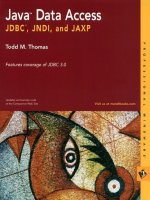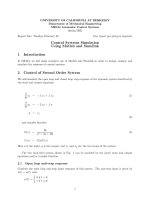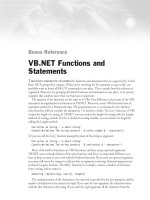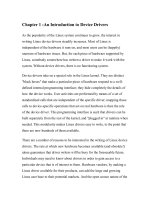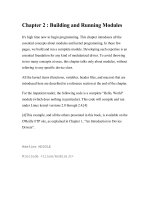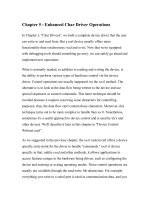Tài liệu Linux Device Drivers-Chapter 13 :mmap and DMA pptx
Bạn đang xem bản rút gọn của tài liệu. Xem và tải ngay bản đầy đủ của tài liệu tại đây (525.05 KB, 109 trang )
Chapter 13 :mmap and DMA
This chapter delves into the area of Linux memory management, with an
emphasis on techniques that are useful to the device driver writer. The
material in this chapter is somewhat advanced, and not everybody will need
a grasp of it. Nonetheless, many tasks can only be done through digging
more deeply into the memory management subsystem; it also provides an
interesting look into how an important part of the kernel works.
The material in this chapter is divided into three sections. The first covers
the implementation of the mmapsystem call, which allows the mapping of
device memory directly into a user process's address space. We then cover
the kernel kiobuf mechanism, which provides direct access to user
memory from kernel space. The kiobuf system may be used to implement
"raw I/O'' for certain kinds of devices. The final section covers direct
memory access (DMA) I/O operations, which essentially provide peripherals
with direct access to system memory.
Of course, all of these techniques require an understanding of how Linux
memory management works, so we start with an overview of that subsystem.
Memory Management in Linux
Rather than describing the theory of memory management in operating
systems, this section tries to pinpoint the main features of the Linux
implementation of the theory. Although you do not need to be a Linux
virtual memory guru to implement mmap, a basic overview of how things
work is useful. What follows is a fairly lengthy description of the data
structures used by the kernel to manage memory. Once the necessary
background has been covered, we can get into working with these structures.
Address Types
Linux is, of course, a virtual memory system, meaning that the addresses
seen by user programs do not directly correspond to the physical addresses
used by the hardware. Virtual memory introduces a layer of indirection,
which allows a number of nice things. With virtual memory, programs
running on the system can allocate far more memory than is physically
available; indeed, even a single process can have a virtual address space
larger than the system's physical memory. Virtual memory also allows
playing a number of tricks with the process's address space, including
mapping in device memory.
Thus far, we have talked about virtual and physical addresses, but a number
of the details have been glossed over. The Linux system deals with several
types of addresses, each with its own semantics. Unfortunately, the kernel
code is not always very clear on exactly which type of address is being used
in each situation, so the programmer must be careful.
Figure 13-1. Address types used in Linux
The following is a list of address types used in Linux. Figure 13-1 shows
how these address types relate to physical memory.
User virtual addresses
These are the regular addresses seen by user-space programs. User addresses
are either 32 or 64 bits in length, depending on the underlying hardware
architecture, and each process has its own virtual address space.
Physical addresses
The addresses used between the processor and the system's memory.
Physical addresses are 32- or 64-bit quantities; even 32-bit systems can use
64-bit physical addresses in some situations.
Bus addresses
The addresses used between peripheral buses and memory. Often they are
the same as the physical addresses used by the processor, but that is not
necessarily the case. Bus addresses are highly architecture dependent, of
course.
Kernel logical addresses
These make up the normal address space of the kernel. These addresses map
most or all of main memory, and are often treated as if they were physical
addresses. On most architectures, logical addresses and their associated
physical addresses differ only by a constant offset. Logical addresses use the
hardware's native pointer size, and thus may be unable to address all of
physical memory on heavily equipped 32-bit systems. Logical addresses are
usually stored in variables of type unsigned long or void *. Memory
returned from kmalloc has a logical address.
Kernel virtual addresses
These differ from logical addresses in that they do not necessarily have a
direct mapping to physical addresses. All logical addresses are kernel virtual
addresses; memory allocated by vmalloc also has a virtual address (but no
direct physical mapping). The function kmap, described later in this chapter,
also returns virtual addresses. Virtual addresses are usually stored in pointer
variables.
If you have a logical address, the macro __pa() (defined in
<asm/page.h>) will return its associated physical address. Physical
addresses can be mapped back to logical addresses with __va(), but only for
low-memory pages.
Different kernel functions require different types of addresses. It would be
nice if there were different C types defined so that the required address type
were explicit, but we have no such luck. In this chapter, we will be clear on
which types of addresses are used where.
High and Low Memory
The difference between logical and kernel virtual addresses is highlighted on
32-bit systems that are equipped with large amounts of memory. With 32
bits, it is possible to address 4 GB of memory. Linux on 32-bit systems has,
until recently, been limited to substantially less memory than that, however,
because of the way it sets up the virtual address space. The system was
unable to handle more memory than it could set up logical addresses for,
since it needed directly mapped kernel addresses for all memory.
Recent developments have eliminated the limitations on memory, and 32-bit
systems can now work with well over 4 GB of system memory (assuming,
of course, that the processor itself can address that much memory). The
limitation on how much memory can be directly mapped with logical
addresses remains, however. Only the lowest portion of memory (up to 1 or
2 GB, depending on the hardware and the kernel configuration) has logical
addresses; the rest (high memory) does not. High memory can require 64-bit
physical addresses, and the kernel must set up explicit virtual address
mappings to manipulate it. Thus, many kernel functions are limited to low
memory only; high memory tends to be reserved for user-space process
pages.
The term "high memory" can be confusing to some, especially since it has
other meanings in the PC world. So, to make things clear, we'll define the
terms here:
Low memory
Memory for which logical addresses exist in kernel space. On almost every
system you will likely encounter, all memory is low memory.
High memory
Memory for which logical addresses do not exist, because the system
contains more physical memory than can be addressed with 32 bits.
On i386 systems, the boundary between low and high memory is usually set
at just under 1 GB. This boundary is not related in any way to the old 640
KB limit found on the original PC. It is, instead, a limit set by the kernel
itself as it splits the 32-bit address space between kernel and user space.
We will point out high-memory limitations as we come to them in this
chapter.
The Memory Map and struct page
Historically, the kernel has used logical addresses to refer to explicit pages
of memory. The addition of high-memory support, however, has exposed an
obvious problem with that approach logical addresses are not available for
high memory. Thus kernel functions that deal with memory are increasingly
using pointers to struct page instead. This data structure is used to keep
track of just about everything the kernel needs to know about physical
memory; there is one struct page for each physical page on the system.
Some of the fields of this structure include the following:
atomic_t count;
The number of references there are to this page. When the count drops to
zero, the page is returned to the free list.
wait_queue_head_t wait;
A list of processes waiting on this page. Processes can wait on a page when
a kernel function has locked it for some reason; drivers need not normally
worry about waiting on pages, though.
void *virtual;
The kernel virtual address of the page, if it is mapped; NULL, otherwise.
Low-memory pages are always mapped; high-memory pages usually are not.
unsigned long flags;
A set of bit flags describing the status of the page. These include
PG_locked, which indicates that the page has been locked in memory, and
PG_reserved, which prevents the memory management system from
working with the page at all.
There is much more information within struct page, but it is part of the
deeper black magic of memory management and is not of concern to driver
writers.
The kernel maintains one or more arrays of struct page entries, which
track all of the physical memory on the system. On most systems, there is a
single array, called mem_map. On some systems, however, the situation is
more complicated. Nonuniform memory access (NUMA) systems and those
with widely discontiguous physical memory may have more than one
memory map array, so code that is meant to be portable should avoid direct
access to the array whenever possible. Fortunately, it is usually quite easy to
just work with struct page pointers without worrying about where they
come from.
Some functions and macros are defined for translating between struct
page pointers and virtual addresses:
struct page *virt_to_page(void *kaddr);
This macro, defined in <asm/page.h>, takes a kernel logical address and
returns its associated struct page pointer. Since it requires a logical
address, it will not work with memory from vmalloc or high memory.
void *page_address(struct page *page);
Returns the kernel virtual address of this page, if such an address exists. For
high memory, that address exists only if the page has been mapped.
#include <linux/highmem.h>
void *kmap(struct page *page);
void kunmap(struct page *page);
kmap returns a kernel virtual address for any page in the system. For low-
memory pages, it just returns the logical address of the page; for high-
memory pages, kmapcreates a special mapping. Mappings created with kmap
should always be freed with kunmap; a limited number of such mappings is
available, so it is better not to hold on to them for too long. kmap calls are
additive, so if two or more functions both call kmap on the same page the
right thing happens. Note also that kmap can sleep if no mappings are
available.
We will see some uses of these functions when we get into the example code
later in this chapter.
Page Tables
When a program looks up a virtual address, the CPU must convert the
address to a physical address in order to access physical memory. The step is
usually performed by splitting the address into bitfields. Each bitfield is used
as an index into an array, called a page table, to retrieve either the address of
the next table or the address of the physical page that holds the virtual
address.
The Linux kernel manages three levels of page tables in order to map virtual
addresses to physical addresses. The multiple levels allow the memory range
to be sparsely populated; modern systems will spread a process out across a
large range of virtual memory. It makes sense to do things that way; it
allows for runtime flexibility in how things are laid out.
Note that Linux uses a three-level system even on hardware that only
supports two levels of page tables or hardware that uses a different way to
map virtual addresses to physical ones. The use of three levels in a
processor-independent implementation allows Linux to support both two-
level and three-level processors without clobbering the code with a lot of
#ifdef statements. This kind of conservative coding doesn't lead to
additional overhead when the kernel runs on two-level processors, because
the compiler actually optimizes out the unused level.
It is time to take a look at the data structures used to implement the paging
system. The following list summarizes the implementation of the three levels
in Linux, and Figure 13-2 depicts them.
Figure 13-2. The three levels of Linux page tables
Page Directory (PGD)
The top-level page table. The PGD is an array of pgd_t items, each of
which points to a second-level page table. Each process has its own page
directory, and there is one for kernel space as well. You can think of the
page directory as a page-aligned array of pgd_ts.
Page mid-level Directory (PMD)
The second-level table. The PMD is a page-aligned array of pmd_t items. A
pmd_t is a pointer to the third-level page table. Two-level processors have
no physical PMD; they declare their PMD as an array with a single element,
whose value is the PMD itself we'll see in a while how this is handled in C
and how the compiler optimizes this level away.
Page Table
A page-aligned array of items, each of which is called a Page Table Entry.
The kernel uses the pte_t type for the items. A pte_t contains the
physical address of the data page.
The types introduced in this list are defined in <asm/page.h>, which
must be included by every source file that plays with paging.
The kernel doesn't need to worry about doing page-table lookups during
normal program execution, because they are done by the hardware.
Nonetheless, the kernel must arrange things so that the hardware can do its
work. It must build the page tables and look them up whenever the processor
reports a page fault, that is, whenever the page associated with a virtual
address needed by the processor is not present in memory. Device drivers,
too, must be able to build page tables and handle faults when implementing
mmap.
It's interesting to note how software memory management exploits the same
page tables that are used by the CPU itself. Whenever a CPU doesn't
implement page tables, the difference is only hidden in the lowest levels of
architecture-specific code. In Linux memory management, therefore, you
always talk about three-level page tables irrespective of whether they are
known to the hardware or not. An example of a CPU family that doesn't use
page tables is the PowerPC. PowerPC designers implemented a hash
algorithm that maps virtual addresses into a one-level page table. When
accessing a page that is already in memory but whose physical address has
expired from the CPU caches, the CPU needs to read memory only once, as
opposed to the two or three accesses required by a multilevel page table
approach. The hash algorithm, like multilevel tables, makes it possible to
reduce use of memory in mapping virtual addresses to physical ones.
Irrespective of the mechanisms used by the CPU, the Linux software
implementation is based on three-level page tables, and the following
symbols are used to access them. Both <asm/page.h> and
<asm/pgtable.h> must be included for all of them to be accessible.
PTRS_PER_PGD
PTRS_PER_PMD
PTRS_PER_PTE
The size of each table. Two-level processors set PTRS_PER_PMD to 1, to
avoid dealing with the middle level.
unsigned pgd_val(pgd_t pgd)
unsigned pmd_val(pmd_t pmd)
unsigned pte_val(pte_t pte)
These three macros are used to retrieve the unsigned value from the typed
data item. The actual type used varies depending on the underlying
architecture and kernel configuration options; it is usually either unsigned
long or, on 32-bit processors supporting high memory, unsigned long
long. SPARC64 processors use unsigned int. The macros help in
using strict data typing in source code without introducing computational
overhead.
pgd_t * pgd_offset(struct mm_struct * mm, unsigned
long address)
pmd_t * pmd_offset(pgd_t * dir, unsigned long
address)
pte_t * pte_offset(pmd_t * dir, unsigned long
address)
These inline functions[50] are used to retrieve the pgd, pmd, and pte
entries associated with address. Page-table lookup begins with a pointer
to struct mm_struct. The pointer associated with the memory map of
the current process is current->mm, while the pointer to kernel space is
described by &init_mm. Two-level processors define
pmd_offset(dir,add) as (pmd_t *)dir, thus folding the pmd over
the pgd. Functions that scan page tables are always declared as inline,
and the compiler optimizes out any pmd lookup.
[50]On 32-bit SPARC processors, the functions are not inline but rather
real extern functions, which are not exported to modularized code.
Therefore you won't be able to use these functions in a module running on
the SPARC, but you won't usually need to.
struct page *pte_page(pte_t pte)
This function returns a pointer to the struct page entry for the page in
this page-table entry. Code that deals with page-tables will generally want to
use pte_pagerather than pte_val, since pte_page deals with the processor-
dependent format of the page-table entry and returns the struct page
pointer, which is usually what's needed.
pte_present(pte_t pte)
This macro returns a boolean value that indicates whether the data page is
currently in memory. This is the most used of several functions that access
the low bits in the pte the bits that are discarded by pte_page. Pages may
be absent, of course, if the kernel has swapped them to disk (or if they have
never been loaded). The page tables themselves, however, are always
present in the current Linux implementation. Keeping page tables in memory
simplifies the kernel code because pgd_offset and friends never fail; on the
other hand, even a process with a "resident storage size'' of zero keeps its
page tables in real RAM, wasting some memory that might be better used
elsewhere.
Each process in the system has a struct mm_struct structure, which
contains its page tables and a great many other things. It also contains a
spinlock called page_table_lock, which should be held while
traversing or modifying the page tables.
Just seeing the list of these functions is not enough for you to be proficient in
the Linux memory management algorithms; real memory management is
much more complex and must deal with other complications, like cache
coherence. The previous list should nonetheless be sufficient to give you a
feel for how page management is implemented; it is also about all that you
will need to know, as a device driver writer, to work occasionally with page
tables. You can get more information from the include/asm and mm subtrees
of the kernel source.
Virtual Memory Areas
Although paging sits at the lowest level of memory management, something
more is necessary before you can use the computer's resources efficiently.
The kernel needs a higher-level mechanism to handle the way a process sees
its memory. This mechanism is implemented in Linux by means of virtual
memory areas, which are typically referred to as areas or VMAs.
An area is a homogeneous region in the virtual memory of a process, a
contiguous range of addresses with the same permission flags. It corresponds
loosely to the concept of a "segment,'' although it is better described as "a
memory object with its own properties.'' The memory map of a process is
made up of the following:
An area for the program's executable code (often called text).
One area each for data, including initialized data (that which has an
explicitly assigned value at the beginning of execution), uninitialized data
(BSS),[51] and the program stack.
[51]The name BSS is a historical relic, from an old assembly operator
meaning "Block started by symbol.'' The BSS segment of executable files
isn't stored on disk, and the kernel maps the zero page to the BSS address
range.
One area for each active memory mapping.
The memory areas of a process can be seen by looking in
/proc/pid/maps(where pid, of course, is replaced by a process ID). /proc/self
is a special case of /proc/pid, because it always refers to the current process.
As an example, here are a couple of memory maps, to which we have added
short comments after a sharp sign:
morgana.root# cat /proc/1/maps # look at init
08048000-0804e000 r-xp 00000000 08:01 51297 /sbin/init # text
0804e000-08050000 rw-p 00005000 08:01 51297 /sbin/init # data
08050000-08054000 rwxp 00000000 00:00 0 # zero-mapped bss
40000000-40013000 r-xp 00000000 08:01 39003 /lib/ld-2.1.3.so # text
40013000-40014000 rw-p 00012000 08:01 39003 /lib/ld-2.1.3.so # data
40014000-40015000 rw-p 00000000 00:00 0 # bss for ld.so
4001b000-40108000 r-xp 00000000 08:01 39006 /lib/libc-2.1.3.so # text
40108000-4010c000 rw-p 000ec000 08:01 39006 /lib/libc-2.1.3.so # data
4010c000-40110000 rw-p 00000000 00:00 0 # bss for libc.so
bfffe000-c0000000 rwxp fffff000 00:00 0 # zero-mapped stack
morgana.root# rsh wolf head /proc/self/maps #### alpha-axp: static ecoff
000000011fffe000-0000000120000000 rwxp 0000000000000000 00:00 0
# stack
0000000120000000-0000000120014000 r-xp 0000000000000000 08:03
2844 # text
0000000140000000-0000000140002000 rwxp 0000000000014000 08:03
2844 # data
0000000140002000-0000000140008000 rwxp 0000000000000000 00:00 0
# bss
The fields in each line are as follows:
start-end perm offset major:minor inode image.
Each field in /proc/*/maps (except the image name) corresponds to a field in
struct vm_area_struct, and is described in the following list.
start
end
The beginning and ending virtual addresses for this memory area.
perm
A bit mask with the memory area's read, write, and execute permissions.
This field describes what the process is allowed to do with pages belonging
to the area. The last character in the field is either p for "private'' or s for
"shared.''
offset
Where the memory area begins in the file that it is mapped to. An offset of
zero, of course, means that the first page of the memory area corresponds to
the first page of the file.
major
minor
The major and minor numbers of the device holding the file that has been
mapped. Confusingly, for device mappings, the major and minor numbers
refer to the disk partition holding the device special file that was opened by
the user, and not the device itself.
inode
The inode number of the mapped file.
image
The name of the file (usually an executable image) that has been mapped.
A driver that implements the mmap method needs to fill a VMA structure in
the address space of the process mapping the device. The driver writer
should therefore have at least a minimal understanding of VMAs in order to
use them.
Let's look at the most important fields in struct vm_area_struct
(defined in <linux/mm.h>). These fields may be used by device drivers
in their mmap implementation. Note that the kernel maintains lists and trees
of VMAs to optimize area lookup, and several fields of vm_area_struct
are used to maintain this organization. VMAs thus can't be created at will by
a driver, or the structures will break. The main fields of VMAs are as
follows (note the similarity between these fields and the /proc output we just
saw):
unsigned long vm_start;
unsigned long vm_end;
The virtual address range covered by this VMA. These fields are the first
two fields shown in /proc/*/maps.
struct file *vm_file;
A pointer to the struct file structure associated with this area (if any).
unsigned long vm_pgoff;
The offset of the area in the file, in pages. When a file or device is mapped,
this is the file position of the first page mapped in this area.
unsigned long vm_flags;
A set of flags describing this area. The flags of the most interest to device
driver writers are VM_IO and VM_RESERVED. VM_IO marks a VMA as
being a memory-mapped I/O region. Among other things, the VM_IO flag
will prevent the region from being included in process core dumps.
VM_RESERVED tells the memory management system not to attempt to
swap out this VMA; it should be set in most device mappings.
struct vm_operations_struct *vm_ops;
A set of functions that the kernel may invoke to operate on this memory
area. Its presence indicates that the memory area is a kernel "object'' like the
struct file we have been using throughout the book.
void *vm_private_data;
A field that may be used by the driver to store its own information.
Like struct vm_area_struct, the vm_operations_struct is
defined in <linux/mm.h>; it includes the operations listed next. These
operations are the only ones needed to handle the process's memory needs,
and they are listed in the order they are declared. Later in this chapter, some
of these functions will be implemented; they will be described more
completely at that point.
void (*open)(struct vm_area_struct *vma);
The open method is called by the kernel to allow the subsystem
implementing the VMA to initialize the area, adjust reference counts, and so
forth. This method will be invoked any time that a new reference to the
VMA is made (when a process forks, for example). The one exception
happens when the VMA is first created by mmap; in this case, the driver's
mmap method is called instead.
void (*close)(struct vm_area_struct *vma);
When an area is destroyed, the kernel calls its close operation. Note that
there's no usage count associated with VMAs; the area is opened and closed
exactly once by each process that uses it.
void (*unmap)(struct vm_area_struct *vma, unsigned
long addr, size_t len);
The kernel calls this method to "unmap'' part or all of an area. If the entire
area is unmapped, then the kernel calls vm_ops->close as soon as vm_ops-
>unmap returns.
void (*protect)(struct vm_area_struct *vma,
unsigned long, size_t, unsigned int newprot);
This method is intended to change the protection on a memory area, but is
currently not used. Memory protection is handled by the page tables, and the
kernel sets up the page-table entries separately.
int (*sync)(struct vm_area_struct *vma, unsigned
long, size_t, unsigned int flags);
This method is called by the msync system call to save a dirty memory
region to the storage medium. The return value is expected to be 0 to
indicate success and negative if there was an error.
struct page *(*nopage)(struct vm_area_struct *vma,
unsigned long address, int write_access);
When a process tries to access a page that belongs to a valid VMA, but that
is currently not in memory, the nopagemethod is called (if it is defined) for
the related area. The method returns the struct page pointer for the
physical page, after, perhaps, having read it in from secondary storage. If the
nopage method isn't defined for the area, an empty page is allocated by the
kernel. The third argument, write_access, counts as "no-share'': a
nonzero value means the page must be owned by the current process,
whereas 0 means that sharing is possible.
struct page *(*wppage)(struct vm_area_struct *vma,
unsigned long address, struct page *page);
This method handles write-protected page faults but is currently unused. The
kernel handles attempts to write over a protected page without invoking the
area-specific callback. Write-protect faults are used to implement copy-on-
write. A private page can be shared across processes until one process writes
to it. When that happens, the page is cloned, and the process writes on its
own copy of the page. If the whole area is marked as read-only, a SIGSEGV
is sent to the process, and the copy-on-write is not performed.
int (*swapout)(struct page *page, struct file
*file);
This method is called when a page is selected to be swapped out. A return
value of 0 signals success; any other value signals an error. In case of error,
the process owning the page is sent a SIGBUS. It is highly unlikely that a
driver will ever need to implement swapout; device mappings are not
something that the kernel can just write to disk.
That concludes our overview of Linux memory management data structures.
With that out of the way, we can now proceed to the implementation of the
mmap system call.
The mmap Device Operation
Memory mapping is one of the most interesting features of modern Unix
systems. As far as drivers are concerned, memory mapping can be used to
provide user programs with direct access to device memory.
A definitive example of mmap usage can be seen by looking at a subset of
the virtual memory areas for the X Window System server:
cat /proc/731/maps
08048000-08327000 r-xp 00000000 08:01 55505
/usr/X11R6/bin/XF86_SVGA
08327000-08369000 rw-p 002de000 08:01 55505
/usr/X11R6/bin/XF86_SVGA
40015000-40019000 rw-s fe2fc000 08:01 10778 /dev/mem
40131000-40141000 rw-s 000a0000 08:01 10778 /dev/mem
40141000-40941000 rw-s f4000000 08:01 10778 /dev/mem
The full list of the X server's VMAs is lengthy, but most of the entries are
not of interest here. We do see, however, three separate mappings of
/dev/mem, which give some insight into how the X server works with the
video card. The first mapping shows a 16 KB region mapped at fe2fc000.
This address is far above the highest RAM address on the system; it is,
instead, a region of memory on a PCI peripheral (the video card). It will be a
control region for that card. The middle mapping is at a0000, which is the
standard location for video RAM in the 640 KB ISA hole. The last
/dev/memmapping is a rather larger one at f4000000 and is the video
memory itself. These regions can also be seen in /proc/iomem:
000a0000-000bffff : Video RAM area
f4000000-f4ffffff : Matrox Graphics, Inc. MGA G200 AGP
fe2fc000-fe2fffff : Matrox Graphics, Inc. MGA G200 AGP
Mapping a device means associating a range of user-space addresses to
device memory. Whenever the program reads or writes in the assigned
address range, it is actually accessing the device. In the X server example,
using mmap allows quick and easy access to the video card's memory. For a
performance-critical application like this, direct access makes a large
difference.
As you might suspect, not every device lends itself to the mmap abstraction;
it makes no sense, for instance, for serial ports and other stream-oriented
devices. Another limitation of mmap is that mapping is PAGE_SIZE
grained. The kernel can dispose of virtual addresses only at the level of page
tables; therefore, the mapped area must be a multiple of PAGE_SIZE and
must live in physical memory starting at an address that is a multiple of
PAGE_SIZE. The kernel accommodates for size granularity by making a
region slightly bigger if its size isn't a multiple of the page size.
These limits are not a big constraint for drivers, because the program
accessing the device is device dependent anyway. It needs to know how to
make sense of the memory region being mapped, so the PAGE_SIZE
alignment is not a problem. A bigger constraint exists when ISA devices are
used on some non-x86 platforms, because their hardware view of ISA may
not be contiguous. For example, some Alpha computers see ISA memory as
a scattered set of 8-bit, 16-bit, or 32-bit items, with no direct mapping. In
such cases, you can't use mmap at all. The inability to perform direct
mapping of ISA addresses to Alpha addresses is due to the incompatible data
transfer specifications of the two systems. Whereas early Alpha processors
could issue only 32-bit and 64-bit memory accesses, ISA can do only 8-bit
